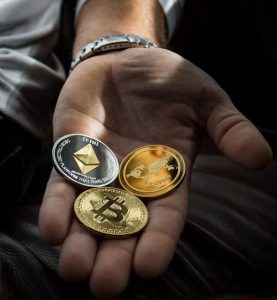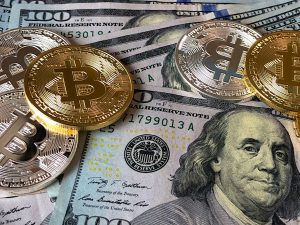
What Is XRP?
XRP is a cryptocurrency and native token of XRP Ledger, an open-source blockchain. The cryptocurrency and blockchain are designed to enhance global financial transfers and the exchange of several currencies. Investors also use it to store value and profit from price fluctuations.
XRP and the XRP Ledger are also used by blockchain services company Ripple on its payment platform to facilitate transactions between financial institutions, businesses, and organizations.
- XRP is a cryptocurrency and the native token of the open-source XRP Ledger, founded in 2012 by David Schwartz, Jed McCaleb, and Arthur Britto.1
- XRP is pre-mined and has a total supply of 100 billion tokens.
- XRP is more cost-effective, has faster transaction times, and is less energy-intensive than Bitcoin.
- XRP, the cryptocurrency, is used but not owned by Ripple, the cryptocurrency services company.
It’s common to see Ripple (the company) associated with ownership of XRP and XRP Ledger. Ripple does not own the blockchain or the cryptocurrency, but it contributes by running six of the unique nodes on the XRPL network.2
The History of XRP
In 2011, Jed McCaleb, David Schwartz, and Arthur Britto started developing the XRP Ledger as a recourse to the inherent limitations of Bitcoin. In 2012, when the XRP Ledger was launched, its native token, XRP, was created to aid its function. The three developers released XRP and XRP Ledger in 2012 and were joined shortly after by Chris Larsen, and the Opencoin company was formed.
The goal behind the XRP Ledger was similar to the vision of Bitcoin creator Satoshi Nakamoto, which was to foster an easier, faster, and more secure way to make transactions globally. The key difference, however, is that it has always been marketed toward businesses rather than consumers, although everyone can use it.
Ripple was the name of the original open-source project, which included XRP (at the time called “ripples”), the Ripple Consensus Ledger, the Ripple Transaction Protocol, and the Ripple Network.
The Opencoin company helped develop the XRP Ledger, but it was rebranded to Ripple Labs (now known as Ripple). It maintained its involvement in the project, which was and remains open source.
The XRP Ledger Foundation was launched in 2020 and funded by donations from Ripple and a few other businesses to maintain and continue developing the XRP Ledger.1
XRP Ledger and XRP
Although XRP is often referred to as Ripple, it’s important to understand that XRP is an open-source cryptocurrency independent of Ripple (the company), which is a cryptocurrency services and technology company. Due to its reported fast, efficient, reliable, carbon-neutral delivery, XRP is the technology that Ripple uses in its solutions.
XRP operates on its decentralized, open-source blockchain, the XRP Ledger (XRPL). Unlike most cryptocurrencies, XRP is pre-mined, with a maximum token supply of 100 billion. The token’s total supply was/are distributed in three ways:
- First, 80 billion XRP tokens were allocated to Ripple (the company). To ensure a stable supply of XRP, 55 billion XRP were locked in an escrow account.
- Then, Ripple co-founders and the core team received the remaining 20 billion XRP.
- The XRP in escrow was scheduled to be released at a rate of 1 billion per month, with the original release schedule targeting 55 months.3
The initial idea behind XRP was straightforward: it was described as a peer-to-peer trust network. XRPL and Ripple cite XRP as a faster, cheaper, and more energy-efficient digital asset that can process transactions within seconds and consume less energy than some counterpart cryptocurrencies.
About 55% of XRP tokens are in circulation.4
XRP is used by Ripple to serve as a settlement layer facilitating the transactions occurring on Ripple Net, Ripple’s commercial platform. It has been traded as a cryptocurrency and is available on several exchanges, including futures, options, swap exchanges, spot exchanges, custodial exchanges, and non-custodial exchanges.
It is important to note that the mechanism behind XRP transactions doesn’t require a transaction fee, which is a standard feature for most cryptocurrencies. Instead, it requires the sender to burn a tiny portion of the XRP, which positions XRP as deflationary.
When a cryptocurrency is described as inflationary or deflationary, it refers to its internal value on a blockchain, not its market value. However, some investors believe that some cryptocurrencies provide protection from inflation, usually because price increases of the popular ones outpace it.
XRP vs. BTC
There are some similarities between XRP and BTC, but there are many more differences. Some of these include the following.
Consensus Mechanisms
The consensus mechanisms used in validating transactions are different. XRP uses a unique consensus mechanism that relies on trusted validators or a Unique Node List (UNL) that decides what transaction to consider for the next ledger. For transactions to become valid, most trusted validators need to agree. On the other hand, Bitcoin relies on miners to solve complex mathematical problems—using proof of work—in validating transactions.
Cheaper, Faster, and Energy Efficient
XRP’s unique consensus mechanism (XRPL Consensus, also called Federated Consensus) allows it to authenticate transactions faster and cheaper. This process consumes far less energy. It’s the opposite for bitcoin and most cryptocurrencies, whose mining processes cause transaction confirmations to take longer and cost far more.5
Scalability of XRP
The XRP ledger is reportedly scalable up to 1,500 transactions per second. With its Payment Channels, it can theoretically scale up to tens of thousands of transactions per second. Payment Channels are opened between transacting parties. The XRP is flagged by the blockchain so that it isn’t spent again, and the parties can send and receive payments while the channel is open. The payments are settled in bulk when the channel is closed. This allows thousands of transactions to be settled at once without tying up the blockchain’s consensus apparatus.
It depends on your outlook for the market and other cryptocurrencies. It’s best to talk to a financial advisor familiar with cryptocurrencies to see if it is suitable for your investing goals.
How Safe Is It to Invest in XRP?
All cryptocurrency prices are volatile, and there is a significant risk of loss. It’s best to discuss XRP with a financial advisor to determine the effect it would have on your portfolio and whether it is safe to invest in it.
XRP is really no different than many other cryptocurrencies. It is the native token of a blockchain that operates like several others. Its position in the market is a function of investor belief and hope and how much they are willing to buy and sell it for.
The Bottom Line
XRP remains one of the top cryptocurrencies in terms of market cap. It can be used just like any other digital currency for transactions or as an investment. If you choose to invest, however, be sure that you don’t invest more than you can afford to lose.
The comments, opinions, and analyses expressed on Investopedia are for informational purposes online. Read our warranty and liability disclaimer for more info. As of the date this article was written, the author does not own cryptocurrency.



